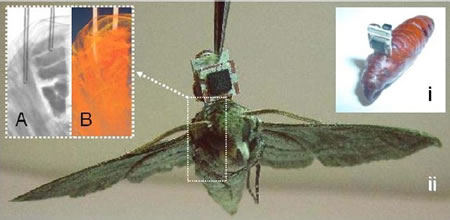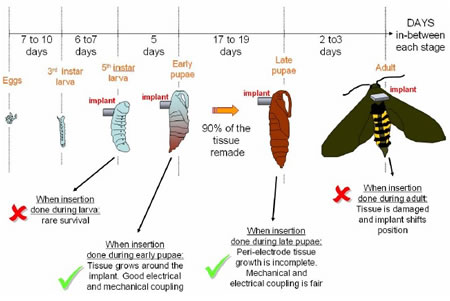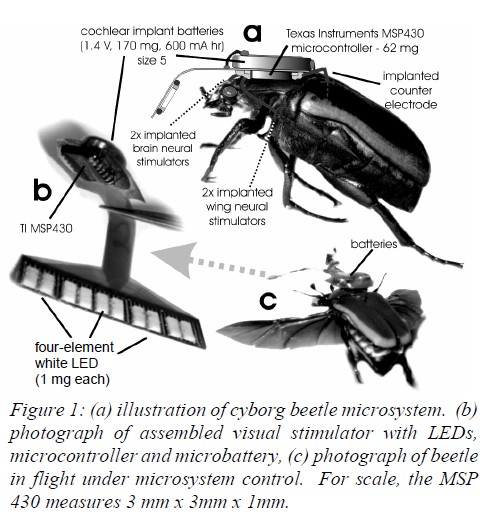The term can also apply to micro-organisms which are modified to perform at higher levels than their unmodified counterparts. In medicine, there are two important and different types of cyborgs: the restorative and the enhanced. Restorative technologies "restore lost function, organs, and limbs". The key aspect of restorative cyborgization is the repair of broken or missing processes to revert to a healthy or average level of function. There is no enhancement to the original faculties and processes that were lost. On the contrary, the enhanced cyborg "follows a principle, and it is the principle of optimal performance: maximising output (the information or modifications obtained) and minimising input (the energy expended in the process)". Thus, the enhanced cyborg intends to exceed normal processes or even gain new functions that were not originally present.
 Military organizations' research has recently focused on the utilisation of cyborg animals for the purposes of a supposed tactical advantage. DARPA has announced its interest in developing "cyborg insects" to transmit data from sensors implanted into the insect during the pupal stage. The insect's motion would be controlled from a Micro-Electro-Mechanical System (MEMS) and could conceivably survey an environment or detect explosives and gas.
Military organizations' research has recently focused on the utilisation of cyborg animals for the purposes of a supposed tactical advantage. DARPA has announced its interest in developing "cyborg insects" to transmit data from sensors implanted into the insect during the pupal stage. The insect's motion would be controlled from a Micro-Electro-Mechanical System (MEMS) and could conceivably survey an environment or detect explosives and gas.

 Cornell University researchers have succeeded in implanting electronic circuit probes into tobacco hornworms as early pupae. The hornworms pass through the chrysalis stage to mature into moths whose muscles can be controlled with the implanted electronics.
The pupal insertion state is shown in insert "i" in the picture seen above. The successful emergence of a microsystem-controlled insect is shown in insert "ii;" the microsystem platform is shown held with tweezers. The X-ray image (A) shows the probes inserted into the dorsoventral and dorsolongitudinal flight muscles. CT images (B) show components of high absorbance indicating tissue growth around the probe.
Cornell University researchers have succeeded in implanting electronic circuit probes into tobacco hornworms as early pupae. The hornworms pass through the chrysalis stage to mature into moths whose muscles can be controlled with the implanted electronics.
The pupal insertion state is shown in insert "i" in the picture seen above. The successful emergence of a microsystem-controlled insect is shown in insert "ii;" the microsystem platform is shown held with tweezers. The X-ray image (A) shows the probes inserted into the dorsoventral and dorsolongitudinal flight muscles. CT images (B) show components of high absorbance indicating tissue growth around the probe.The research also indicated the most favorable and least favorable times for insertion of control devices. The overall size of the circuit board is 8x7 mm, with a total weight of about 500 mg. The capacity of the battery is 16 mAh, and weighs 240 mg. A driving voltage of 5 volts causes the tobacco hornworm blade muscles (two pairs) to move for flight and maneuvering. DARPA HI-MEMS program director Amit Lal credits science fiction writer Thomas Easton with the idea. Lal read Easton's 1990 novel Sparrowhawk, in which animals enlarged by genetic engineering were outfitted with implanted control systems. Dr. Easton, a professor of science at Thomas College, sees a number of applications for HI-MEMS insects. Moths are extraordinarily sensitive to sex attractants, so instead of giving bank robbers money treated with dye, they could use sex attractants instead. Then, a moth-based HI-MEMS could find the robber by following the scent." "[Also,] with genetic engineering Darpa could replace the sex attractant receptor on the moth antennae with receptors for other things, like explosives, drugs or toxins," said Easton.
Artificial tissue can already be grown on three-dimensional scaffolds made of biological materials that are not electrically active. And electrical components have been added to cultured tissue before, but not integrated into its structure, so they were only able to glean information from the surface. A research team combined these strands of work to create electrically active scaffolds. They created 3D networks of conductive nano-wire studded with silicon sensors. Crucially, the wires had to be flexible and extremely small, to avoid impeding the growth of tissue. The scaffold also contained traditional biological materials such as collagen.
The researchers were able to grow rat neurons, heart cells and muscle in these hybrid meshes. In the case of the heart cells, they started to contract just like normal cells, and the researchers used the network to read out the rate of the beats. When they added a drug that stimulates heart cell contraction, they detected an increase in the rate, indicating the tissue was behaving like normal and that the network could sense such changes.
The team also managed to grow an entire blood vessel about 1.5 centimetres long from human cells, with wires snaking through it. By recording electrical signals from inside and outside the vessel– something that was never possible before– the team was able to detect electrical patterns that they say could give clues to inflammation, whether tissue has undergone changes that make it prone to tumour formation or suggest impending heart disease.
Possible uses for this type bio electrical engineering is that you could use these things to directly measure the effects of drugs in synthetically grown human tissue without ever having to test them in an actual human being. So far, though, the researchers have only used the electrical scaffolds to record signals– they have yet to feed commands to cells. The next step could be to add components to the nanoscaffold that could "talk" to neurons.
Researchers in Chicago have gone even further. The Neural Engineering Center for Artificial Limbs has developed techniques that combine myo-electric limbs with nerve transplants to deliver even finer motor control, with patients even being able to feel the objects they grip or touch.
 Our merger with machines is already happening. We replace hips and other parts of our bodies with titanium and steel parts. More than 50 000 people have tiny computers surgically implanted in their heads with direct neural connections to their cochleas to enable them to hear. In the testing stage, there are retina microchips to restore vision and motor implants to give quadriplegics the ability to control computers with thought. Robotic prosthetic legs, arms, and hands are becoming more sophisticated. I don't think I'll live long enough to get a wireless Internet brain implant, but my kids or their kids might.
Our merger with machines is already happening. We replace hips and other parts of our bodies with titanium and steel parts. More than 50 000 people have tiny computers surgically implanted in their heads with direct neural connections to their cochleas to enable them to hear. In the testing stage, there are retina microchips to restore vision and motor implants to give quadriplegics the ability to control computers with thought. Robotic prosthetic legs, arms, and hands are becoming more sophisticated. I don't think I'll live long enough to get a wireless Internet brain implant, but my kids or their kids might.And then there are other things still further out, such as drugs and genetic and neural therapies to enhance our senses and strength. While we become more robotic, our robots will become more biological, with parts made of artificial and yet organic materials. In the future, we might share some parts with our robots which will lead into prolonging life. From the simple idea of replacing limbs to complete body repair, technology has a realistic claim to make a human cyborg. Granted it still in the early stages of bio electrical engineering, but with every technological advance grows the appeal of artificial improvement. Could this appeal grow over the next few decades and reach a consumer market?. The cost of artificial eye a Argus II implant is around $115,000 which is a high price for a 60 pixel screen on your eyeball. But maybe that price will drop down and with better interconnectivity or Augmented reality software, these cyborgs will most likely have a unfair advantage over the rest of us humans.




No comments:
Post a Comment